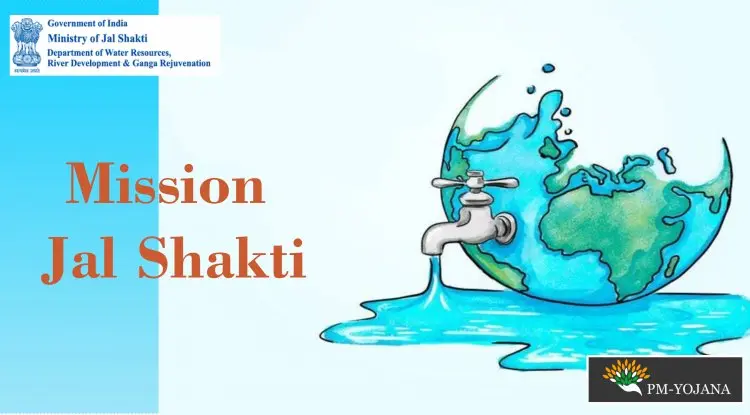Ministry of Jal Shakti
The Ministy of Jal Shakti is implementing the National Rural Drinking Water Programme (NRDWP) and Jal Jeevan Mission .

Ministry of Jal Shakti
The Ministy of Jal Shakti is implementing the National Rural Drinking Water Programme (NRDWP) and Jal Jeevan Mission .
'JAL SHAKTI ABHIYAN'
Overview
The average annual water availability in any region largely depends on hydro-meteorological and geological factors; however, the population of a country determines the water availability per person. Due to rising population, spatial variations in precipitation and high temporal conditions, India’s per capita water is gradually diminishing and water availability in numerous regions is lower than the national average, leading to water stress and scarcity in the country.
To combat this looming crisis, Prime Minister Narendra Modi launched the Jal Shakti Abhiyan: Catch the Rain campaign (with a tagline ‘Catch the rain, where it falls, when it falls’) on World Water Day, which was observed on March 22, 2021. This programme focuses on collecting and conserving rainwater. It will be implemented from March 22, 2021, to November 30, 2021, covering the pre-monsoon and monsoon periods across urban and rural areas in the country.
| Ministry of Jal Shakti | |
| Date of Formation | May 2019 |
| Governing Ministers | Gajendra Singh Shekhawat, Cabinet Minister and Rattan Lal Kataria, Minister of State |
| Jurisdiction | Republic of India |
Jal Shakti Abhiyan: Catch the Rain
The government launched the ‘Jal Shakti Abhiyan: Catch the Rain’ campaign as a Jan Andolan (mass movement) to encourage water conservation at the grassroot level via active participation of people. Rainwater—collected in the 4-5 months of monsoon—is the only source of water for most parts in the country. So, this scheme is aimed to mandate all stakeholders to build rainwater harvesting infrastructure, according to the climatic conditions and subsoil strata in a particular area, to ensure proper storage of rainwater.
In his launch address, Prime Minster Narendra Modi asserted that India's self-sufficiency relies on the country’s water resources and water connectivity and that rapid development is not possible without water security and effective water management. He said that better management of rainwater will help tackle issues of less water and therefore, the success of such campaigns is important. He also urged people to boost water conservation efforts and undertake water management work such as desilting and deepening & widening of water bodies, before the onset of monsoon, so that the country can be well-prepared to conserve rainwater.
After this, the Prime Minister interacted with the Gram Sabhas of each district to discuss issues related to water conservation. These Gram Sabhas took the Jal Shapath (an oath) for water conservation.
Ongoing Government Initiatives
Apart from rainwater harvesting, the government will also focus on the management of river water. To achieve this objective, the Ministry of Jal Shakti and the Governments of Madhya Pradesh and Uttar Pradesh have signed a memorandum of agreement (MOA), in the presence of the Prime Minister, to implement the Ken-Betwa Link Project, which will be the first project under the National Perspective Plan (NPP) for interlinking rivers. Under the NPP, the National Water Development Agency (NWDA) identified 30 links (16 under the Peninsular Component and 14 under the Himalayan Component) for preparing feasibility reports (FRs).
The Ken-Betwa Link Project includes proposed construction of the Daudhan Dam and a canal to link water flow between the Ken and Betwa rivers. This plan also comprises the Lower Orr Dam Project, Kotha Barrage Project and the Bina Complex Irrigation and Multipurpose Project. As per the government, this interlinking of rivers project will facilitate annual irrigation of 10.62 lakh hectares, enable drinking water supply to ~62 lakh people and generate 103 MW of hydropower.
Moreover, this link project is likely to aid the water-deficit regions of Bundelkhand; Districts of Damoh, Datia, Vidisha, Shivpuri, Panna, Tikamgarh, Sagar, Chhatarpur and Raisen of Madhya Pradesh and Mahoba; and Jhansi, Banda and Lalitpur of Uttar Pradesh.
Prior to this initiative, the central government, under the Ministry of Jal Shakti, had launched ‘Jal Jeevan Mission – Har Ghar Jal’ on August 15, 2019, with an outlay of Rs. 3.60 lakh crore (US$ 51.50 billion). The mission aimed to ensure accessibility of piped water in every rural household in the country by 2024. Until the launch, only 3.23 crore rural households were reported to have tap water supply out of the total 18.93 crore rural households in the country. As of March 23, 2021, 3.92 crore rural households have been provided tap water connections. Currently, the total number of targeted households are 19.19 crore, of which 7.16 crore rural households have been provided tap water connections under the mission. Further, the mission, in partnership with the Department for Promotion of Industry and Internal Trade (DPIIT), launched an innovation challenge to develop portable water testing devices. Through this exercise, the government wanted to develop an innovative, modular and cost-effective solution that can be used at the village/household level to instantly, easily and accurately test the quality of drinking water.
In reference to the ‘Jal Jeevan Mission – Har Ghar Jal’ programme, the Prime Minister stated that post-independence, the government made significant efforts towards testing water potability in the country. He added that rural women have been made stakeholders in this campaign and ~4.5 lakh women were trained for water testing amid COVID-19; every village will appoint at least five such trained women for water testing.
On March 23, 2021, the Union Cabinet, chaired by the Prime Minister, approved a memorandum of cooperation (MoC) between the Ministry of Water Resources, River Development and Ganga Rejuvenation and the Ministry of Jal Shakti of India and Water and Disaster Management Bureau and the Ministry of Land, Infrastructure, Transport and Tourism of Japan for collaborations in the field of water resources. This MoC aims to develop long-term collaboration in the fields of water and delta management and water technology to increase the exchange of information, knowledge, technology and scientific & allied experiences, and implement joint projects between the two countries. This partnership is likely to help enhance water security, improve irrigation facilities and achieve sustainability in the development of water resources.
The Road Ahead…
Under the ‘Jal Jeevan Mission’, Andaman & Nicobar Islands, Goa and Telangana have achieved the 100% target of providing functional tap water connections to every rural household. Similarly, through Jal Shakti Abhiyan, the government is aiming to build resilient systems that ensure water availability even in the most vulnerable regions and provide long-term solutions for sustainable use of water in the country.
Objectives of Jal Shakti Ministry
The Jal Shakti Ministry focuses on issues such as international and inter-state water disputes, cleaning of the Ganga, its tributaries and sub-tributaries and also aims in providing clean drinking water. The formation of this ministry targets towards the mounting water challenges faced by India over the past few decades.
Some important schemes/initiatives/programmes that are taken care of by the Jal Shakti Ministry are:
- Jal Jeevan Mission
- Jal Shakti Abhiyan
- Atal Bhujal Yojana
- Namami Gange Programme
- National Aquifer Mapping Programme
- PM Krishi Sinchayee Yojana
National Water Mission
The National Water Mission was launched by PM Narendra Modi under the National Action Plan for Climate Change (NAPCC) to tackle the threats of global warming. The National Water Mission emphasizes on conservation of water and minimizing the wastage. It also ensures the equitable distribution of water across and within the states through the development and management of integrated water resources. The major goals of the National Water Mission are as follows:
- To reduce and study the impact of climate change on water resources and to provide comprehensive water database in the public domain.
- Promotion of citizen and state actions for water conservation, augmentation and preservation.
- To focus on the vulnerable areas including over-exploited areas and also to increase the water use efficiency by 20%.
- To promote the management of basin level integrated water resources.
To know about the advantages of the National Water Mission, refer to the linked article.
Water Scarcity in India
The 2018 Composite Water Management Index (CWMI) noted that 6% of economic GDP will be lost by 2050, while water demand will exceed the available supply by 2030.
India has 18% of the world’s population which has access to only 4% of the usable water sources. Poor management of resources and lack of government attention has contributed as a major factor for water scarcity in India. As per NITI Aayog report released in June 2019, India is facing the worst-ever water crisis in history. Approximately 600 million people or roughly around 45 % of the population in India is facing high to severe water stress. The report goes on to say that nearly 40 % of the population will have absolutely no access to drinking water by 2030 and 6 % of India’s GDP will be lost by 2050 due to the water crisis.
As per the publication by Jal Shakti Ministry; by 2030, the industrial activity will require four times the volume of water it used in 2020.







